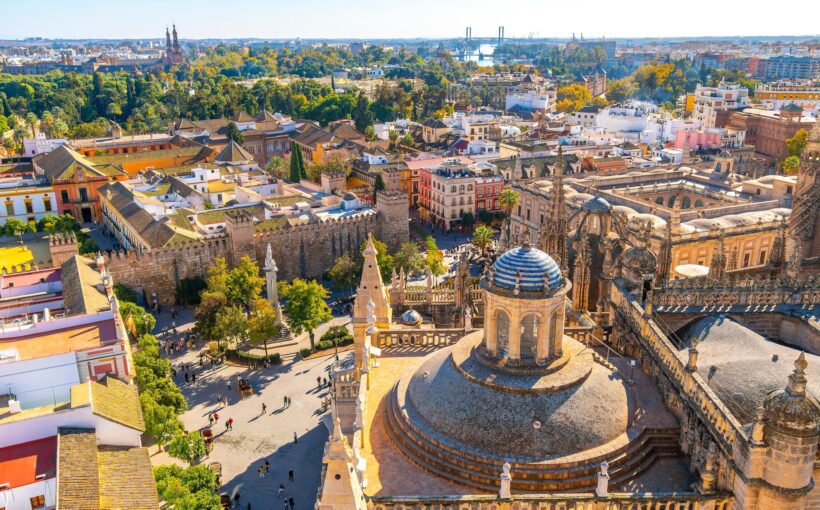
There has been backlash from some conservative Catholics in Spain this week, who object to an image of Jesus on a poster used to promote Holy Week in Seville. The image has been described as homoerotic, effeminate, camp and sexualised.
Religious imagery is widespread in western popular culture, from music videos to fashion, TV shows to advertising. In her book Admen and Eve, writer Katie Edwards explains that “Eve is quite the money maker” and signposts the prolific use of Eve in marketing campaigns for products including cider, cereal, cigarettes and perfumes.
In my own research, I have explored representations of Moses in advertising. The figure of Moses, an elderly, male, disabled prophet from the book of Exodus, is usually replaced by young, nude women shown parting the red sea, in various advertisements including one for suncream.
While the use of religious characters such as Eve and Moses often goes unnoticed, adverts that use the image of Jesus frequently cause an outcry. There’s been a backlash against using his image in advertising, including for Greggs’ vegan rolls, Samsung mobile phones and even jeans.
The history of icons and the church
The current outrage in Spain has precedents. There has been anger about explicit images of Jesus used in films about his life such as Monty Python’s “blasphemous” film Life of Brian (1979) and Mel Gibson’s The Passion of the Christ (2004), which depicts the crucifixion as a bloody sacrifice. Some portrayals of the crucifixion have been implicit, such as Cersei’s walk of shame in Game of Thrones, which echoes the Via Dolorosa — the path Jesus walked to the crucifixion.
Certain denominations of Christianity, such as Pentecostalism and Methodism, do not engage with icons or images of God, following their prohibition in the book of Exodus. Yet, icons have a long and significant history in the Orthodox and Roman Catholic traditions, as objects worthy of veneration.
Representations of Jesus are prolific in this sense. The depiction of the crucifixion – his semi-nude, broken body on a cross – adorns churches and jewellery worldwide. So much so that we have become almost desensitised to the violence depicted in this type of image. These images are often in children’s classrooms if they attend faith schools.

Christianity and the body
Art critic Leo Steinberg’s book, The Sexuality of Christ in Renaissance Art and Modern Oblivion (1983), showcases how crucifixion imagery was once quite explicit, as historically many images did not afford Jesus the modesty of a loincloth. Jesus’ body has always been a site of controversy, despite Christianity being a religion that is quite concerned with bodies.
Christianity is an embodied religion, where beliefs are not simply spiritual, but are enacted through, by and on the body. Think immaculate conceptions and virgin births. Sacraments such as baptism (immersion in water), anointing and the Eucharist involve physical movements (praying, bowing) and the senses (tasting, smelling) alongside visual, sacred symbols.
God becoming flesh – the incarnation – is the basis of Christian understandings of Jesus. In Roman Catholicism, there is a belief in transubstantiation, that Christ is present in the consumption of the bread and wine (representing body and blood) during holy communion. The bread, or wafer, literally becomes Christ’s body for human consumption, following Jesus’ instruction “take this and eat it, this is my body”. In her book Indecent Theology (2000), the late queer theologian, Marcella Althaus-Reid describes such an activity as “cannibalistic”.
In my own book The Bible and Sexual Violence Against Men (2021), I explore how Jesus is presented as asexual, both in the Bible and in Christian theology. The Bible tells very little of Jesus’ sexuality, and for a Jewish man in his thirties, the absence of wife and family would have been noticeable.
Asexuality seems to be a family affair. It’s suggested that his earthly parents, the virgin Mary and Joseph were both abstinent or celibate. Such celibacy is proscribed for priests in Roman Catholicism, and marriage is tackled in Paul’s letter to the Corinthians, where he says “it is good for them to stay unmarried, as I do”.
Representation and reception
Those in Spain who have objected to Jesus being portrayed as “effeminate”, “camp” or “sexualised” seem to imply that there is something wrong or deviant about such portrayals. More globally, this speaks back to the legacy of homophobia in certain conservative Christian settings and the use of the Bible in this. The debate continues, even with inclusive advancements from Pope Francis in relation to the blessing of same-sex unions.
While controversies reign around the image of a “sexualised” Jesus in Spain, this portrayal has a more obvious controversy that has not received attention. Jesus, a Middle Eastern, brown-skinned man, has been white-washed. The depiction of Jesus as a white European is problematic.
In Matthew’s gospel, Jesus is reported to ask: “Who do you say that I am?. Representations and images of Jesus are often context specific and context based – and therefore the reception of such images are, too.

Looking for something good? Cut through the noise with a carefully curated selection of the latest releases, live events and exhibitions, straight to your inbox every fortnight, on Fridays. Sign up here.
![]()
Chris Greenough does not work for, consult, own shares in or receive funding from any company or organisation that would benefit from this article, and has disclosed no relevant affiliations beyond their academic appointment.



